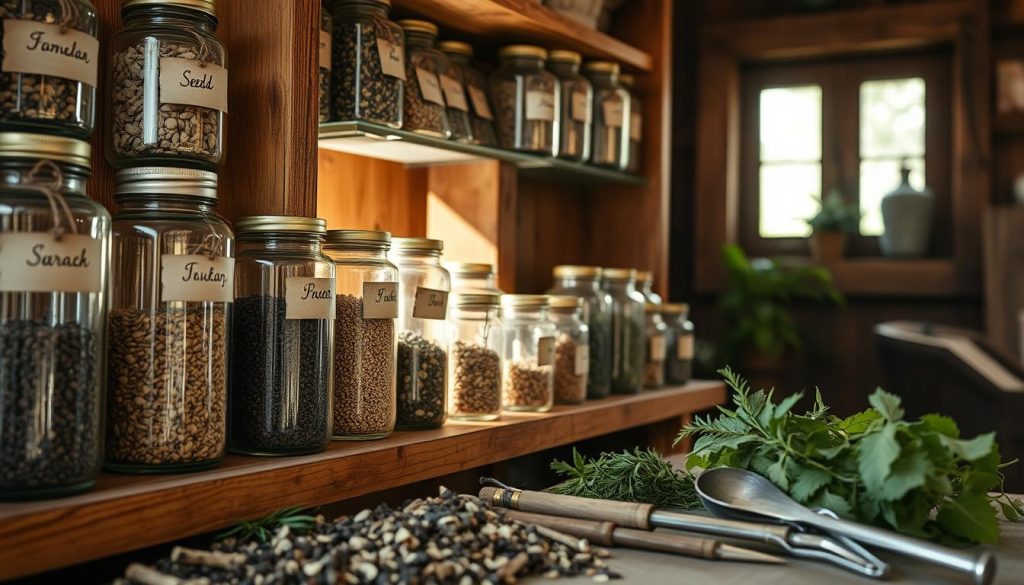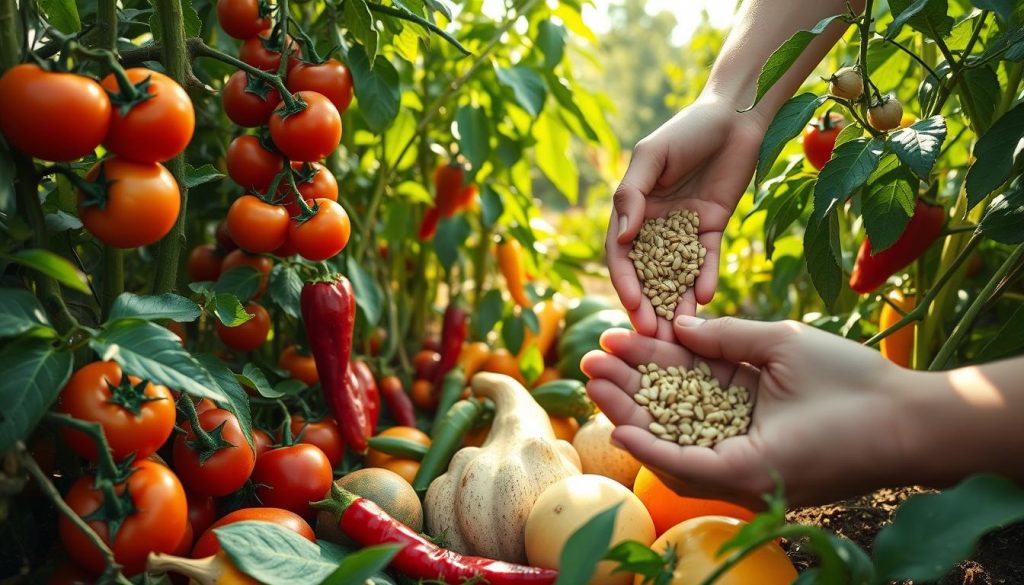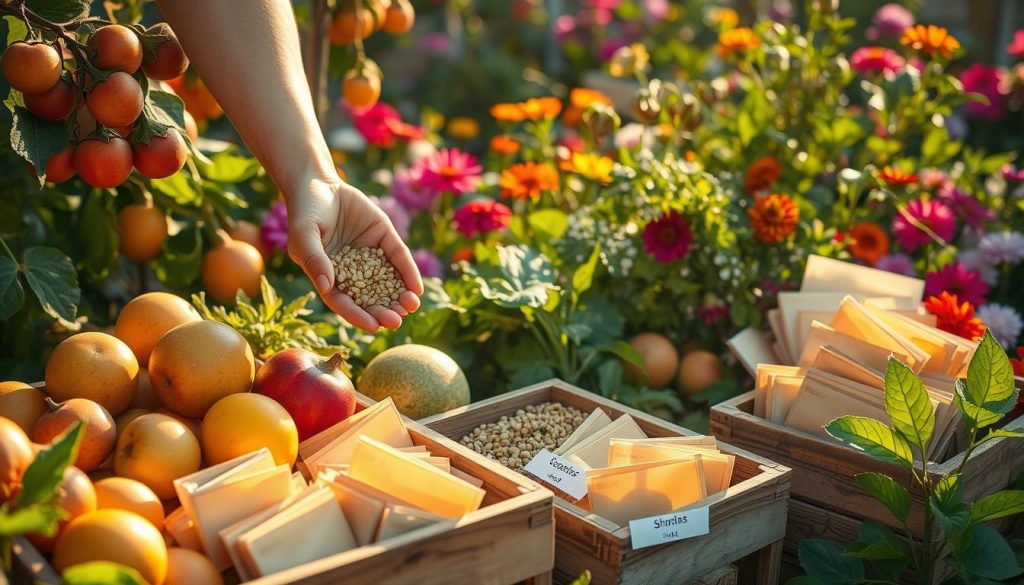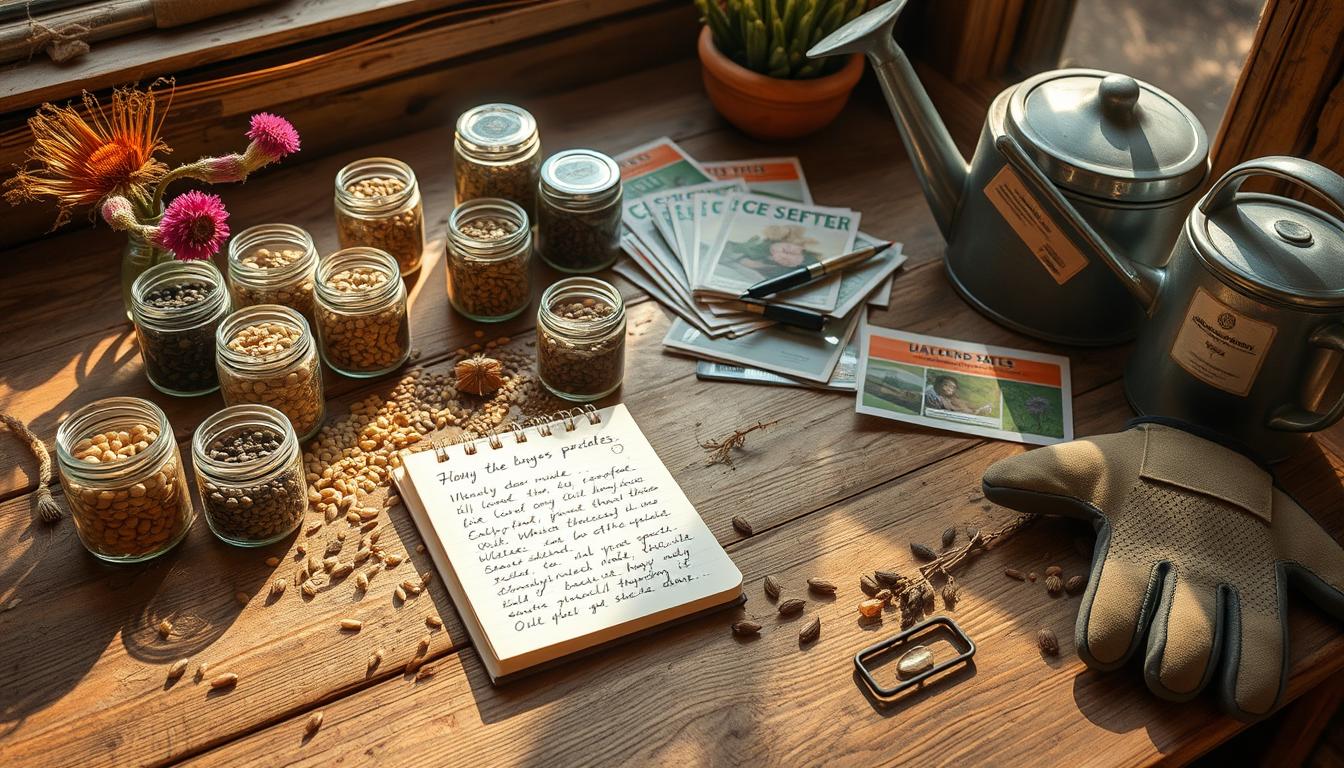I’m excited to share my experience with saving seeds for next season. It’s a key part of gardening that lets me keep my favorite varieties. It also helps me save money on seeds. Learning to save seeds is a skill every gardener should know, and I’m here to share my tips with you.
By saving seeds, I ensure a steady supply of fresh produce. I keep the quality of my garden high. I follow a simple process to collect, store, and plant seeds. This way, I get the best results.
In this article, I’ll guide you through saving seeds for next season. I’ll cover the best practices for saving and storing seeds. I’ll also share insights to help you succeed in your gardening journey.
Why Saving Seeds is Important
Saving seeds is key to keeping your favorite plants healthy. It lets your plants keep growing and giving you great food. You also learn more about your plants’ life cycle.
Seed saving helps keep plant types diverse. It’s vital for saving heirloom varieties. Plus, it saves money since you don’t have to buy new seeds every year. Start by learning how to store seeds properly in a cool, dry spot.
Benefits of Seed Saving
- Preserves plant diversity
- Cost-effective
- Allows for the development of new plant varieties

Preserving Plant Diversity
Keeping plant diversity healthy is crucial. It helps plants adapt to new environments. Saving seeds from different plants is key for this.
Cost-Effectiveness
Seed saving can save you money. It means you don’t have to buy new seeds every year. This is great for gardeners who grow many types of plants.
Choosing the Right Plants for Seed Saving
Choosing the right plants is key to saving vegetable seeds. Not all plants are good for seed saving. It’s important to pick the right varieties to save seeds for next year. Knowing the difference between heirloom and hybrid plants helps a lot.
Heirloom plants are great for saving seeds. They’ve been around for a long time and their seeds work well when replanted. Hybrid plants, on the other hand, are made for specific traits and their seeds might not keep those traits.
Heirloom vs. Hybrid Plants
Here are some key factors to consider when deciding between heirloom and hybrid plants:
- Seed quality: Heirloom seeds are often more reliable and consistent.
- Flavor and texture: Heirloom plants usually have more complex flavors and textures.
- Disease resistance: Hybrid plants may have disease resistance, but heirloom plants can develop their own over time.
Understanding Plant Life Cycles
Knowing a plant’s life cycle is important for saving seeds. Different plants grow and produce seeds at different times. Some plants are ready in 60 days, while others take months.

Signs of Seed Readiness
It’s also important to know when seeds are ready. This can vary by plant. But common signs include:
- Seed pods turning brown or dry
- Seeds becoming loose or easy to remove from the plant
- Plants producing a large number of seeds
By picking the right plants and understanding their life cycles, you can save vegetable seeds successfully. This saves money and lets you enjoy your favorite varieties year after year.
The Best Time to Harvest Seeds
Harvesting seeds at the right time is key for saving and storing them. It keeps them viable and of good quality. To find the best time, watch for signs of seed maturity. Look for a hard outer shell or a color change.
Timing is everything in seed saving. Each crop has its own needs. For example, tomatoes and peppers are ready when their fruit is fully ripe. Beans and peas are ready when their pods are dry and brittle.

To get the best results, learn the seed saving needs of each crop. Check seed saving guides or online resources. By doing this, gardeners can save seeds for future use.
Monitoring Seed Maturity
- Check seeds regularly for signs of readiness
- Research specific seed saving requirements for each crop
- Use the right seed saving methods to ensure viability and quality
Timing for Different Crops
Knowing when to harvest seeds is crucial for seed saving. Harvesting at the right time ensures seeds are viable and of high quality. This makes saving and storing them easier for the future.
Step-by-Step Guide to Collecting Seeds
Collecting seeds is easy once you know how. It’s key to keep seeds alive for a good harvest. You’ll need the right tools and methods to save seeds for next year.
Before you start, gather your equipment. You’ll need paper bags, envelopes, and scissors. These tools help you store seeds well, keeping them fresh longer.
Tools You’ll Need
- Paper bags or envelopes for storing seeds
- Scissors for cutting seed pods or stalks
- A small brush for gently removing seeds from plants
Techniques for Different Seed Types
Choosing the right method is important for each seed type. For tomatoes and peppers, cut the seed pod and let it dry. For lettuce and spinach, brush the seeds off the plant. This way, you can save seeds for next year and have a great harvest.
Cleaning and Preparing Seeds
After collecting, clean and prepare your seeds. Remove any dirt or plant parts and dry them well. This step keeps seeds alive for next year’s garden.
Storing Seeds for Longevity
Keeping seeds viable for a long time requires the right storage. Seed saving tips emphasize the importance of cool, dry, and dark places. The best temperature for storing seeds is between 40°F and 50°F.
Choosing the right containers is key for seed storage. You can use:
- Airtight glass jars or containers
- Paper envelopes or bags
- Seed storage boxes or cases
Store these containers in a dry place, like a basement or cupboard. This keeps moisture away from the seeds.
It’s important to label and organize your seeds well. Include the seed type, date harvested, and any notes on the label. This helps you use the freshest seeds for planting. By following these tips, you’ll have a successful harvest for years.
Best Practices for Seed Saving
To keep your seeds quality and pure, follow the best seed saving practices. It’s key to avoid cross-pollination, which can ruin your seeds. When saving seeds from vegetables, use the right storage methods to keep them fresh.
Some important seed saving tips include:
- Avoid cross-pollination by separating different plant varieties
- Store seeds in a cool, dry place
- Keep seeds away from sunlight and moisture
By sticking to these practices, your seeds will stay healthy and ready for future use. Saving seeds from vegetables can be very rewarding. With the right methods, you can enjoy a big harvest for many years.
Avoiding Cross-Pollination
Stopping cross-pollination is vital when saving vegetable seeds. You can do this by separating plants or using barriers to block pollen. This way, your seeds will stay true to their variety.
Keeping Seed Etiquette in Mind
When saving seeds, remember to follow seed etiquette. This means labeling and storing seeds correctly and sharing them responsibly. By doing this, you help keep your seeds healthy and your garden thriving for years.
Planning for Next Season’s Garden
Now that you’ve saved and stored your seeds, it’s time to plan for next year’s garden. Saving seeds for the future is key for a rich harvest every year. By saving seeds, you’re moving towards self-sufficiency and cutting down on commercial seed costs.
When to Start Seeds Indoors
Start some seeds indoors a few weeks before the last frost date, depending on your area and crops. This lets seedlings grow strong roots before moving outside. Check local guides or seed packets for the best start time.
Transitioning Seedlings Outdoors
When moving seedlings outside, harden them off slowly. Start by exposing them to more sunlight and outdoor conditions over a week or two. This helps them adjust and prevents shock.
Creating a Planting Calendar
Make a planting calendar to keep track of when to start seeds indoors, transplant them outside, and when they’ll be ready. It helps you make the most of your growing season and keep a steady supply of fresh food all year.
section>

